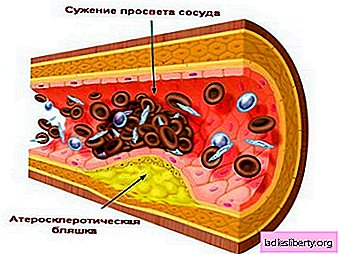
Atherosclerosis - a chronic disease characterized by proliferation of the walls of the medium and large arteries of the connective tissues (sclerosis) in conjunction with the fat soaking of their inner membranes (athero-). As a result of thickening, the walls of the vessels become denser, their lumen narrows, which often causes the formation of blood clots. Depending on the place of damage to the arteries, the blood circulation of a particular site or organ is disturbed with the likelihood of necrosis (gangrene, heart attack). Reducing the capacity of blood vessels and narrowing the lumens in the end can lead to their complete blockage.
Atherosclerosis continues to occupy a leading position in terms of morbidity and mortality. Most often, this disease occurs in women over 60 and in men 50-60 years old.
Atherosclerosis - Causes
Long-term clinical studies have proved that atherosclerosis is a pathological self-sustaining process that occurs in the vessels, the causes of which are: diabetes mellitus, arterial hypertension, smoking, obesity, unhealthy diet, impaired metabolism of fatty acids and fat, excessive emotional stress, sedentary lifestyle, hereditary predisposition. The emergence of atherosclerosis also contribute to stress, depression, neurosis, emotional overload. Disorders in lipid metabolism lead to the development of this disease. Cholesterol deposited on the inner walls of arterial vessels eventually forms plaques and growths. Constantly developing, this process inevitably leads to vascular wall deformation.
Atherosclerosis - symptoms and manifestations
The clinical picture of the disease depends on the area and prevalence of atherosclerotic lesions, but is always the result of insufficient blood supply to the tissue or organ. So, for atherosclerosis of the aorta is characterized by gradually increasing arterial hypertension and noise, auditioned above the abdominal and ascending aorta. In such situations, a complication of the stratified aortic aneurysm is possible with the subsequent death of the patient.
Atherosclerosis of the upper aortic arch is characterized by insufficient blood supply to the brain (fainting, dizziness, strokes). With atherosclerosis of the mesenteric arteries that feed the intestine, two main symptoms are characteristic: firstly, thrombosis of arterial branches with necrosis of the walls of the mesentery and intestine; secondly, abdominal toad - bouts of colicky pain in the abdomen that occur after eating and are often accompanied by bloating and vomiting. Atherosclerosis of the renal arteries is characterized by a violation of the blood supply to the kidneys, which leads to persistent arterial hypertension. In the future, this leads to chronic renal failure and nephrosclerosis.
Atherosclerosis - diagnosis
If any symptoms of atherosclerosis appear, you need to see a doctor. Modern complex diagnostics can detect the disease in the early stages. With the help of laboratory tests, a study of the biochemical composition of blood, cholesterol and lipid metabolism is carried out, the work of the adrenal glands is diagnosed. Ultrasound examination of blood vessels reveals the presence of atherosclerosis and determines the degree of vascular damage.
Atherosclerosis - treatment and prevention
In the treatment of atherosclerosis, such measures as normalization of weight, rational physical activity, complete cessation of smoking and alcohol abuse, regular intake of special medications are necessary. It is necessary to observe a diet where fish and vegetable fats prevail over animals.
The treatment of atherosclerosis should be comprehensive, individual, taking into account the main causes and associated diseases. Timely treatment can not only slow down the development of the disease, but reverse it, avoiding serious complications such as stroke and myocardial infarction, significantly improve blood supply to the heart, brain and internal organs, thereby minimizing the risk of premature death.
Comments











